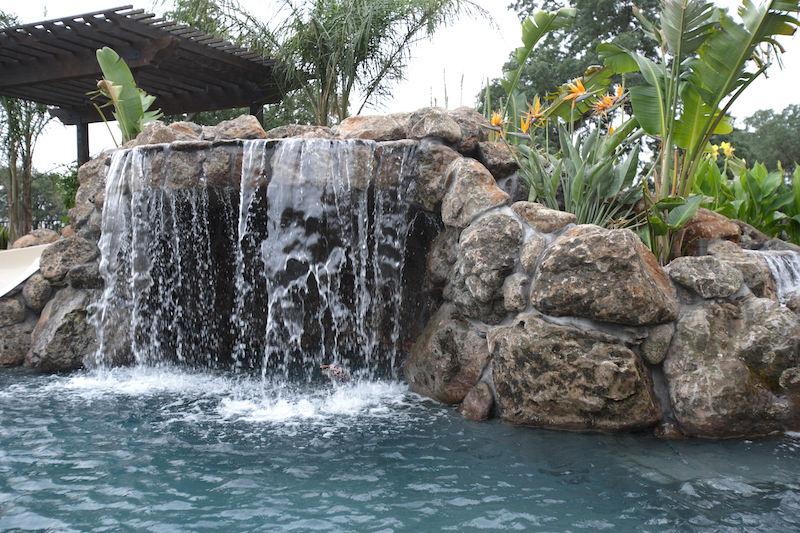Table of Contents:
- Enhancing Your Backyard with a Water Feature
- The Art of Designing Backyard Water Features
- Installing Water Features
- Maintaining Water Features
- Choosing the Right Materials
- Navigating the Selection of Water Plants
- Adding Lighting to Your Water Feature
- FAQs in Relation to Backyard Water Features
- Conclusion
Enhancing Your Backyard with a Water Feature
A backyard water feature is an impressive way to elevate your outdoor space, creating not just aesthetic appeal but also a calming environment. The sound of running water has been shown to reduce stress and promote relaxation.
The benefits extend beyond personal enjoyment; adding such features can increase the value of your property as well. Homeowners who invest in their backyards often see increased resale values, making it more than just about enhancing living spaces – it’s about financial gains too.
Differentiating Your Property with Water Features
An attractive water feature could give you that competitive edge if selling becomes part of future plans. Potential buyers are drawn towards homes offering unique amenities like garden fountains or small ponds – features that set properties apart from others on the market.
In addition to boosting curb appeal and potentially increasing home value, these additions offer homeowners themselves immense satisfaction, as they have their own private oasis right at home where they can relax after long days or entertain guests during warm summer evenings.
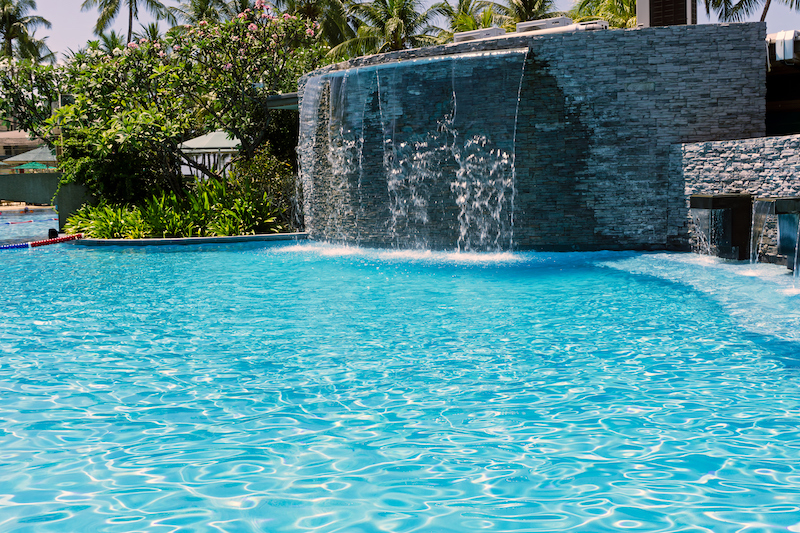
Exploring Various Types Of Water Features
The range for backyard water features extends wide, from simple bird baths serving as quaint focal points in gardens to elaborate koi ponds delivering dramatic visual impacts – and there’s something suitable for every homeowner out there looking into this upgrade option.
If movement appeals most, consider aquatic wildlife – a pond filled with colorful fish adds life while providing the tranquil sounds falling waters make. But those seeking simplicity might find a standalone fountain enough to meet their needs and desires, considering the maintenance and care required to ensure longevity and functionality over time – every choice comes with its considerations and requirements to remember when planning.
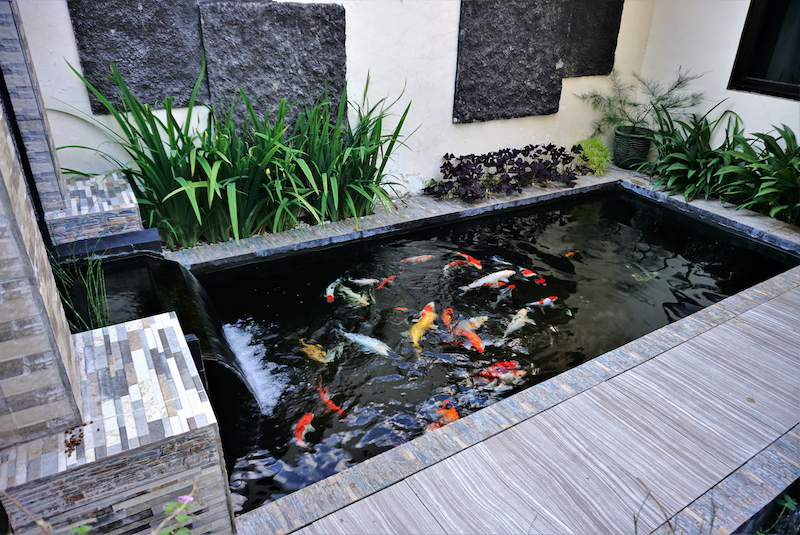
Adding a water feature to your backyard not only enhances its aesthetic appeal but also creates a serene atmosphere. It’s more than just an upgrade; it can boost property value and provide personal enjoyment. From simple bird baths to elaborate koi ponds, there’s something for every homeowner.
The Art of Designing Backyard Water Features
Designing backyard water features is a blend of creativity, strategic planning, and understanding the nuances of your outdoor space. The size, shape, and location are key considerations when envisioning how to add water features that enhance the landscape design.
The first step in this process involves studying your backyard thoroughly. Considerations such as sunlight exposure throughout the day can significantly impact both the functionality and aesthetic appeal of small waterfall or garden fountain installations.
Choosing a Style for Your Water Feature
Select an appropriate style next; modern geometric designs offer clean lines while traditional naturalistic styles bring organic shapes inspired by nature itself into play. Inspiration abounds on various internet platforms where you can find myriad backyard water feature ideas. Better yet, you can leave the style options to experts who will create the perfect water feature to match your backyard.
Incorporating Elements in The Design
A well-designed water feature seamlessly integrates various elements – rocks, pebbles, statues – depending on personal preferences and the overall theme of your yard. You could also consider adding aquatic life forms to introduce movement with running waters creating soothing sounds and enhancing tranquility within the area. Remember: Aesthetic appeal must be balanced against functional aspects.
Pumps & Filtration Systems: Vital Cogs
Last but certainly not least are pumps and filtration systems which form integral parts of any functioning large fountains or even small pond setups. Aquarium Adviser provides comprehensive guides, explaining how different types work together seamlessly within these setups. A well-designed system will keep standing waters clean, reducing maintenance efforts considerably.
Installing Water Features
Installing water features, such as a small waterfall or garden fountain, in your outdoor space is an art form that requires precision and knowledge. The process involves several critical components, such as pumps for moving water, plumbing systems to connect the feature’s elements together, and effective filtration methods.
The heart of any backyard water feature is its pump system. A well-chosen pump not only creates the soothing sound of running or falling water but also keeps standing water from becoming stagnant, preventing unsightly algae growth and discouraging mosquitoes. It’s important to note that there are various types available on the market, including submersible models suitable for smaller installations like bird baths or larger external units perfect for koi ponds.
Plumbing systems act as arteries, connecting all parts of your backyard oasis and ensuring clean flowing streams without leaks that could lead to unwanted consequences, such as damage due to dampness over time.
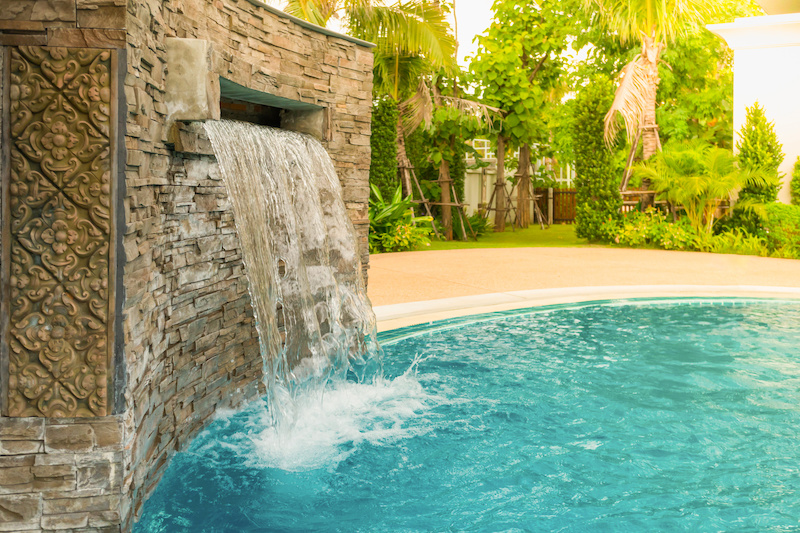
Filtration Methods And Their Importance
Filtration plays a crucial role in maintaining clear waters by removing debris while balancing nutrient levels, which can otherwise cause murky appearances or unpleasant odors if left unchecked. Depending on the size, you might need mechanical filters capable of trapping solid particles, biological filters breaking down harmful substances, or even both. Regularly checking these filters prevents clogs and maintains optimal performance.
Location Matters In Installations
Selecting the ideal location within your outdoor area is key to a successful installation. Factors such as sunlight exposure, proximity to trees (potentially shedding leaves into the pool), wind direction, and slope gradient, among others, must be considered when deciding where to best install it. Local building codes should be kept in mind to ensure no violations occur during the creation of your dream home oasis.
Remember: While DIY-ing the project may seem appealing, professional help from companies like MG Construction & Decks ensures accuracy, safety, efficiency, and adherence to legal requirements.
Installing backyard water features is an art, requiring a keen understanding of pump systems, plumbing connections, and filtration methods. Location selection also plays a crucial role in the success of the installation. While DIY might be tempting, professional assistance guarantees precision and compliance with local building codes.
Maintaining Water Features
Water features, whether it’s a small waterfall or an elaborate koi pond, require regular maintenance to preserve their allure and functionality. Maintaining a water feature not only makes it the focal point of your outdoor area but also provides a calming atmosphere.
The first step in maintaining these backyard marvels is ensuring they remain clean. This involves removing debris, such as leaves, that may have fallen into them using simple tools like a net. Additionally, keeping algae at bay is crucial for both aesthetic appeal and the overall health of any aquatic plants or fish present.
Fish are common inhabitants in many water features. If you choose to add some to yours, remember that feeding should be done sparingly. Overfeeding can lead to poor water quality due to uneaten food decomposing in the water, which could potentially cause damage over time.
Pump Maintenance: The Heartbeat Of Your Water Feature
Your pump plays a critical role – it’s essentially the heart that keeps your beautiful garden fountain alive by moving water through its veins (pipes). Regular inspection ensures there are no blockages affecting performance.
A more detailed cleaning process might involve disassembling parts, including filters and impellers, depending on manufacturer guidelines. It’s important that this task isn’t overlooked because neglecting it could result in serious issues down the line.
Maintain Filtration System To Keep Waters Clear And Clean
In addition to pumps working efficiently, having a functional filtration system is equally vital. These systems work hard behind the scenes, filtering out waste materials from circulating waters, thereby contributing towards crystal clear running waters. As part of routine checks, ensure filter media aren’t clogged up with dirt and replace them when necessary following manufacturers’ instructions.
Keep your backyard water feature sparkling and serene with regular maintenance. This includes clearing debris, controlling algae, feeding fish sparingly to maintain water quality, inspecting the pump for blockages, and ensuring a functional filtration system. Remember – a well-kept water feature is not just eye candy but also an oasis of tranquility.
Choosing the Right Materials
The decision to add water features is significant, as it can completely transform your outdoor area. But an essential part of this process involves selecting suitable materials that will not only complement your backyard’s aesthetic but also withstand various weather conditions and the passing of time.
Natural stone has always been a popular choice for many homeowners due to its timeless elegance and variety in colors and textures. However, they require regular sealing procedures to prevent any potential staining or damage from natural elements over time.
In contrast, concrete offers durability with added flexibility in design since it can be molded into different shapes according to preference. It presents itself as an affordable alternative capable of mimicking other high-end materials like brick or stone without compromising on quality. This makes concrete ideal for those who wish their garden fountain or small waterfall feature to maintain both functionality and style while staying within budget constraints.
Metal Features
Stainless steel or copper are excellent choices if you’re aiming for modern elegance in your landscape design. They promise longevity but may demand more maintenance than others due to possible corrosion issues when left untreated.
Glass is another material worth considering if you prefer sleek lines coupled with reflective surfaces that enhance the moving water effect.
Fiberglass & Resin
If weight restrictions apply because of limited space, such as a small yard, fiberglass and resin become attractive options owing to their lightweight nature.
These alternatives might lack some visual appeal compared to previous mentions; however, affordability paired with a considerable lifespan make them worthy contenders, especially when installed by experts.
Navigating the Selection of Water Plants
When adding water features to your backyard space, one crucial aspect is choosing suitable aquatic plants. These living components not only beautify but also contribute significantly to maintaining an ecological balance within this miniature ecosystem.
The first step involves understanding different types of aquatic flora: submerged (or oxygenators), floating, and marginal or bog varieties. Submerged species like hornwort live beneath the water surface, providing essential oxygen for any fish in your small pond, while floating ones such as duckweed offer shade that helps control algae growth by limiting sunlight exposure.
Marginal or bog plants grow along edges or shallow areas of your garden fountain, adding structure and height while helping with filtration by absorbing excess nutrients from standing water. Native plant species are more likely to thrive without becoming invasive, so consider those when selecting marginals for your outdoor area.
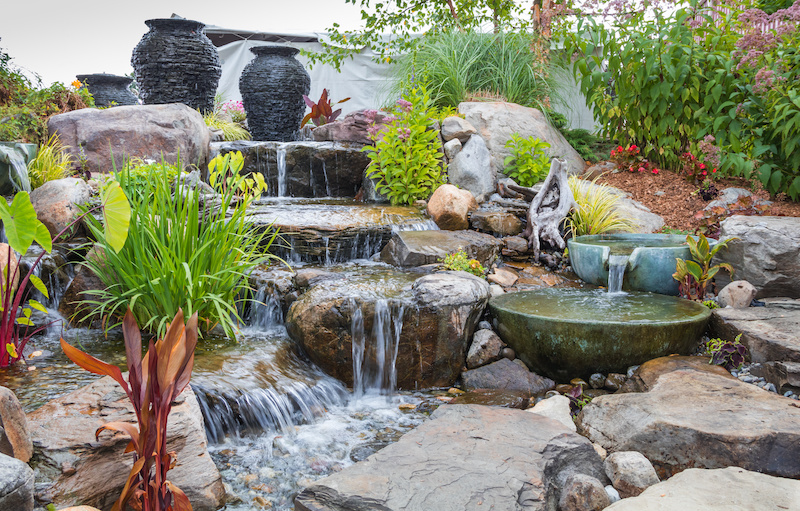
Considering Aesthetic Elements in Plant Choice
Apart from their functional roles, these green additions can enhance visual appeal if chosen thoughtfully. Consider how each will blend with other elements in terms of color coordination. Lotus flowers or lilies could complement colorful flowers already present elsewhere around your yard. Ensure you take note of their mature size too, avoiding overcrowding issues later down the line.
Ensuring Proper Care For Your Selected Flora
Your selected plants need appropriate care routines tailored toward ensuring optimal health and vitality within their new habitat. This includes regular pruning during growing seasons, typically spring through fall, removing dead foliage promptly before it decomposes into harmful substances that could upset the delicate equilibrium created here.
Other factors include feeding schedules, and substrate materials conducive to root development, amongst others. These form integral aspects related to guaranteeing the long-term success of the ornamental additions to the overall landscape design surrounding your residential property premises.
Choosing the right aquatic plants for your backyard water feature is a two-fold task: picking species that maintain ecological balance and enhance visual appeal. This involves understanding different types of flora, considering aesthetics, and ensuring proper care routines to ensure long-term success.
Adding Lighting to Your Water Feature
In the realm of backyard beautification, lighting plays a pivotal role in amplifying the allure of water features. The strategic integration of lights not only accentuates your outdoor area but also enhances safety by illuminating potential hazards.
Diverse Light Options for Water Features
The market offers an array of outdoor lighting choices, each with its unique charm and functionality. From submersible LED lights that add a mystical underwater glow to spotlight fixtures highlighting key elements like small waterfalls or colorful flowers, there’s something for every taste and requirement.
Your choice should align with both aesthetic aspirations and practical needs. For instance, if you have aquatic plants or fish gracing your garden fountain or koi pond, consider using submersible LEDs as they enhance their visibility while adding depth to the overall design.
Strategic Placement is Key
Meticulous placement can dramatically elevate how light interacts with running water, creating captivating patterns on surrounding surfaces such as patio covers or pergolas. In addition, layers are created when different depths are illuminated, providing visual interest. However, beware of over-lighting, which could result in glare rather than inviting ambiance.
Safety First: Waterproof Fixtures & GFCI Protection
When mixing electricity and standing water, careful consideration must be given to safety measures. Waterproof fixtures designed specifically for use near bodies of moving water ensure longevity. The National Fire Protection Association (NFPA) recommends employing Ground Fault Circuit Interrupter (GFCI) protection. This device instantly cuts off power upon detecting any imbalance, thereby minimizing risk.
Maintenance Matters:
Regular maintenance ensures optimal performance from installed lights. Cleaning lenses regularly prevents buildup, which could diminish output, and prompt bulb replacement keeps illumination consistent. Bear in mind, different bulbs will offer varying degrees of lighting, so be sure to make the right selection for your needs.
Lighting can elevate your backyard water feature from good to great. Choose lights that suit both your style and practical needs, place them strategically for maximum effect without causing glare, and ensure they’re waterproof with GFCI protection for safety. Regular maintenance keeps the glow consistent.
FAQs in Relation to Backyard Water Features
Are backyard water features worth it?
Absolutely. Backyard water features can enhance the aesthetic appeal of your outdoor space, create a relaxing ambiance, and potentially increase property value.
What is a water feature in the backyard?
A backyard water feature could be anything from fountains to ponds or streams that incorporate flowing or still water into landscape design.
What are the benefits of water features?
Beyond aesthetics, they offer relaxation through their soothing sounds, attract wildlife like birds and butterflies, and help in reducing noise pollution by drowning out traffic or neighbor noises.
How do you maintain a backyard water feature?
Maintenance involves regular cleaning to remove debris, checking for leaks or damage regularly, maintaining proper pH levels in the case of ponds with fish, and ensuring pumps function correctly.
Conclusion
Backyard water features can truly transform your outdoor space into a haven of tranquility and beauty.
You’ve figured out how to craft an impressive display that’ll have your neighbors green with envy.
The installation process, though complex with its pumps and filtration systems, is doable with the right guidance.
Maintenance isn’t as daunting as it seems – regular cleaning keeps things running smoothly.
Material selection plays a big role too; stone or concrete, each has its own charm.
Add in some plants for a touch of greenery and life around your water feature.

